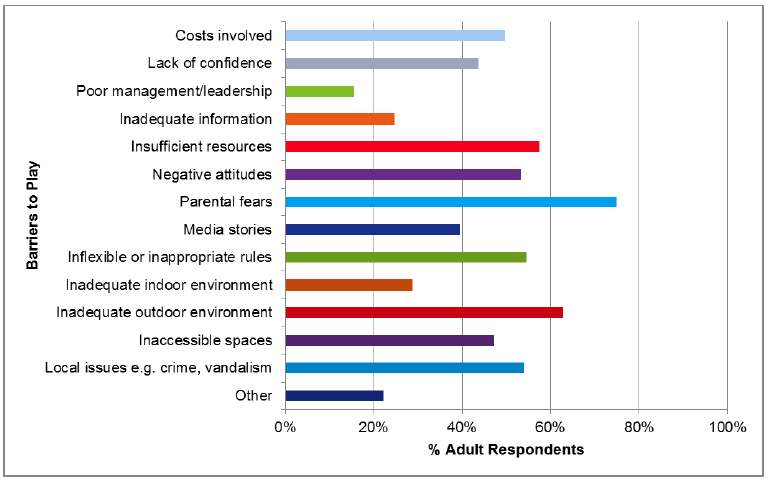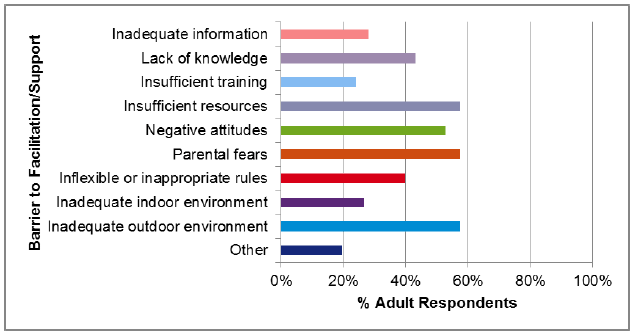Scotland's Play Strategy: Playing with quality and equality: a review of inclusive play in Scotland
A review of inclusive play in Scotland.
8. In the community - adults' survey
In the context of the 'In the community', what do you feel are barriers to being able to participate fully in play?

Figure 13 Adults' survey
The graph above illustrates the range of barriers considered to be a barrier to inclusive play opportunities in the community particularly, parental fears, inadequate outdoor spaces, insufficient resources, inappropriate rules (e.g. no balls signs), and negative attitudes.
"Distance to adequate play areas is a worrying factor. Children usually want to go alone as they get older, but if the distance is too great, there is fear amongst parents re the safety of their children."
"I think bullying is an issue in play parks / open spaces and how can this be managed? It absolutely discourages children from going to a local play park or playing in a local bit of grass."
"There are a number of new play spaces / play parks (in the local authority area), having visited most of them I am always sad to see how little there is for children who are less able or in wheel chairs"
"Some great facilities in our area (e.g. schools), but only for use during school hours, and fees for evening and weekend use make them unaffordable."
"Having tried pushing wheelchairs and buggies up forestry paths is akin to ploughing through custard with a dodgy shopping trolley!! (...) These free places on our doorstep definitely need to be more accessible (…) very little info is available for parents of disabled children regarding this, surfacing can be extremely painful to wheelchair users & NHS does not provide off road wheelchairs to the disabled"
"Where we live there are no ball game signs on every available free space and neighbours complain of children chalking pictures on the ground etc. The planning of a new primary school has the neighbouring houses up in arms regarding the mess and noise of children playing…The best play schemes and equipment are all in vain whilst these attitudes exist. Seeing and listening to children at play should be a joy not a bugbear."
This question also prompted responses which indicated a need for different types of support.
"There is a lack of support for parents with learning disabilities to find new places for our kids to go to. There is a lack of easy read information about clubs and resources."
"Being an extremely rural area children who have a visual impairment are unable to access certain things in their home and local community. They might have to travel huge distances for support groups or access to indoor soft play and there is a lack of sensory play rooms available outwith the main hub of Inverness-shire. Many parents (… ) feel socially excluded, attending the local parent and tot groups they often feel excluded with nobody talking to them (this is the parents views), my professional views are that they feel their little ones are not the same, they see the other 'sighted' children reaching milestones which their child is many many months behind and this is sad and upsetting (...) Specialist support groups really work well here but they are not accessible for people living in the rural (and very far away) areas due to such small numbers."
"wish there were more supported 'clubs' available for children to attend from an early age - like youth clubs but supported by staff across ages - much like cubs/brownies/church groups but without the uniform/religion - just a safe place for children to play with their friends - and learn to take risks"
In the context of inclusive play 'In the community', do you feel there is anything that stops us being able to facilitate, support or promote play opportunities that respond to children and young people's play needs and wishes?

Figure 14 Adults' survey
A similar range of barriers was identified here: inadequate outdoor environment, insufficient resources, negative attitudes, parental fears.
"Cost is a likely factor, but, for example, I have observed at length, boys at skate parks and it is incredible that kids of various ages (10 - 18+) get on so well, allow each other to take centre stage, make way for different equipment (skates, BMX bikes, scooters, skateboards). Money is well spent on such play areas where things run very smoothly."
"Not enough CLD (Community Learning and Development) staff to coordinate appropriate community action, too many tokenistic short term projects for a long term / permanent issue"
"Our culture is a long way from integrating disabled and non-disabled children, we need to move on from 'special' provision and support children to be integrated in a mixed environment."
"I work with the population of children who have social, emotional and behavioural needs in addition to the ADHD and Autism Spectrum Disorder and other health needs which impact on behaviour. This all gets lumped into 'bad behaviour' "
In the context of inclusive play 'In the community', would you suggest play opportunities should be supported differently in some way from the way they are currently?
This question prompted 101 comments. The following illustrate the main themes and practical suggestions. These relate to a number of levels at which a difference might be made from local community levels and schools to planning, local authorities and Scottish Government levels.
"I would like to see a provision for local residents for indoor play (particularly during the wet/cold weather). The closest soft play is 30 minutes by car and 1 hour by public transport. There is nothing within walking distance for the local community. This would support a wide cross-section of the children in inclusive play. And local parent/children consultation for changes/improvements to the outdoor parks would be wonderful, to ensure we are meeting the needs of a larger selection of the local children. And please, can we just have one of these wild play/junk yards for free outdoor play for the slightly older children, free from unnecessary rules and regulations?"
"Thinking of school grounds as a "community resource" Raising play opportunities up the agenda of community councils"
"Given there are problems in a limited number of open spaces it would be good if this was facilitated by community officers who have a level of authority. Facilities should be monitored in the evening and weekends as well as daytime. There is a lack of indoor/covered play facilities for the dark nights/poor weather throughout the country."
"Inclusive play should form part of local planning guidance in new developments and where regeneration of town centres are being planned"
"Responsibility to get children into play has to be delegated back to parents. Infrastructure has to improve to ensure that area's where people live become 'living areas' rather than parking spaces and traffic funnels. Play has to return to the street, to create a 'living street'."
"if this is so important to the Scottish Government they should fund it but also make it easier for groups to get the ground for play equipment"
In the context of 'In the community', can you give us any examples of times when things were set up really well, support was offered in such a way that really helped, or in which children and young people's wishes were genuinely respected in a way that helped them feel included?
"The most memorable examples are when there is some degree of facilitation from an organisation or community presence to encourage and support the young people as well as provide a form for advocacy so the young people can have their voices heard through the community council for example."
"Pop up Play; Mud Day events where activities were set out for children of all ages; stages of development and abilities."
This is the outcome we are aiming for
"All children have sufficient time and space (physical and social) for playing within their community and have contact with nature in their everyday lives. Play is valued, encouraged and supported in communities, as are providers of community play providers such as out of school care, playgroups, therapeutic and specialist settings and community champions of play" Play Strategy for Scotland: Our Vision (2013) Scottish Government.
These are things that would help achieve this
It would help if:
- The Risk-Benefit Assessment approach was firmly embedded and implemented consistently. (See also Section 7 above)
- Schemes such as Play Rangers / Community Playworkers were extended so that there is visible support to play in play spaces, parks and neighbourhood spaces.
- In every Local Authority/Community Planning Partnership area Play Policies, Strategies and accompanying Action Plans were developed which include explicit aims, objectives and actions to make tangible progress towards inclusive practices, programmes and environments.
- Communities were invited to contribute and engage in local programmes and activities.
- A positive lead was given by the Play Strategy Implementation Group to development of a network of "play champions" underpinned by the principles set out in the Play Strategy and the UN Convention article 31; with explicit reference to progress on inclusion - non-discrimination, equality of opportunity, participation - as integral to the role.
Contact
Email: Deborah Gallagher
There is a problem
Thanks for your feedback